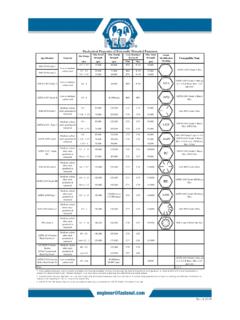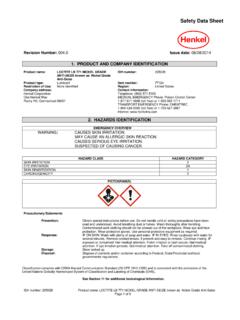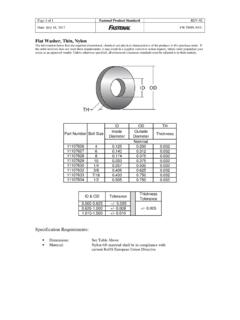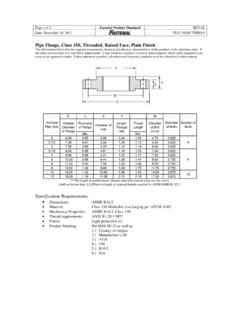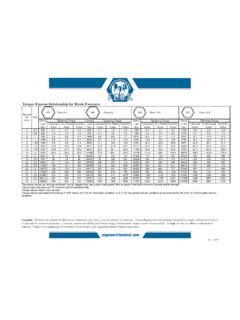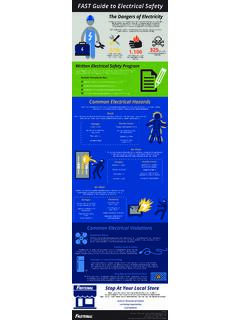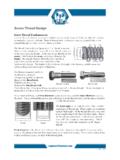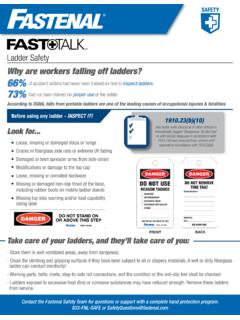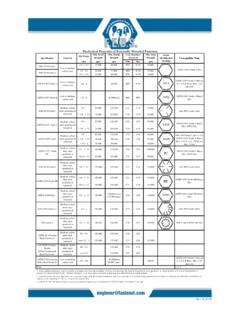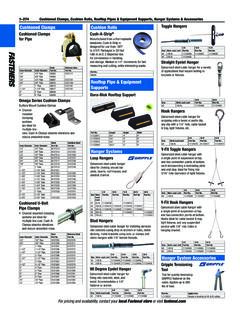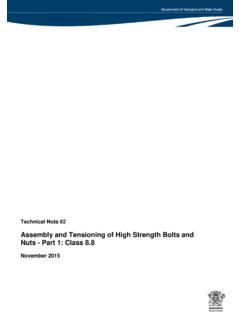Transcription of Structural Bolts Feb-26-09 DONE - Fastenal
1 Rev. 3-4-09 Structural Bolting ASTM A325 and ASTM A490 are the two standard Structural Bolts . When looking at the mechanical requirements of Bolts it appears that an ASTM A325 and SAE J429 Grade 5 are identical as do the ASTM A490 and the SAE J429 Grade 8. This begs the question, Can an SAE J429 Grade 5 be used when an ASTM A325 is specified? The answer is definitely no. This is also the case for substituting a Grade 8 when A490 is specified, and here are some reasons why: First, A325 and A490 Bolts are produced with a heavy hex head configuration which provides a wider bearing surface over which to distribute the load. Grade 5 and 8 Bolts are produced to standard hex cap screw configuration and therefore cannot distribute the load as much as is needed for Structural applications. Second, the shank length (non-threaded portion of the body) on the A325 and A490 Bolts is designed to be greater (shorter thread lengths) than your standard hex bolt or hex cap screw.
2 Remember, the weakest section of standard carbon steel fasteners is through the threaded region. Minute design changes such as this can create a stronger tensile connection. Third, the difference in thread length is also likely to result in a change in shear strength. The following two diagrams demonstrate this difference: If both Bolts are -10 x 4, Bolt X has the shear plane acting through the body of the bolt, while Bolt N has its shear plane acting through the threaded portion. Assuming that both fasteners have an ultimate shear capacity of 72,000 PSI, just how many pounds would each fastener be capable of handling? To determine the load in pounds, one must first calculate the area of material for each example. Notice the Grade 5 has a much smaller head configuration and a shorter shank then the A325 Structural bolt.
3 Rev. 3-4-09 Bolt X has the cross sectional area in the shank (body diameter). Therefore, in the worst case scenario the minimum body diameter is inches. By applying the principles of geometry one can calculate the area of a circle with this diameter. Bolt X has a material cross sectional area of square inches. Take sq-in. and multiply by 72,000 PSI and you re left with nearly 30,000 pounds. For Bolt N s calculation the root area must be used (as the shear plane intersects the threads), which is sq-in. Now take this and multiply by the same 72,000 PSI and it results in approximately 21,740 pounds. By merely ensuring that the shear load is applied to the body of the bolt, the shear strength can improve by 8,260 pounds. On the other hand, if the application calls for the shank to be in the shear plane, substituting a Grade 5 (with its longer thread length) would place the threads in the shear plane, resulting in an 8,260 lbs.
4 Reduction in shear strength. Oftentimes, drawings and blueprints indicate the Structural bolt with an X or an N designation. The X indicates that the threads are excluded from the shear plane whereas the N indicates that the threads may be included in the shear plane. Structural Bolts are specifically designed for use with heavy hex nuts in the connection of Structural members (as opposed to tapped holes). The nuts for Structural connections shall conform to ASTM A563 or ASTM A194. The following chart will assist in proper Structural nut selection. The washers used for Structural connections shall meet ASTM F436 specifications. This specification covers both flat circular and beveled washers. Mechanical Properties of ASTM A325 and A490 Structural Bolts (in.)(psi)(psi) - 185,000120,000C25C341 1/8 - 1 1/274,000105,000C19C301/4 - 185,000120,000C25C341 1/8 - 1 1/274,000105,000C19C301/4 - 1 1/2120,000150,000 (min)C33C39173,000 (max)1/4 - 1 1/2120,000150000 (min)C33C39173,000 (max)Grade DH (plain)Grade DH3 Min.
5 Tensile StrengthCore Hardness RockwellGrade C3 Grade DH3 ASTM A563 Compatible Heavy Hex NutGrade Identification MarkingASTM A325 Type 3 Weathering steel: quenched & temperedMedium carbon steel: quenched & temperedASTM A325 Type 1 Size RangeMin. Proof StrengthASTM A490 Type 1 Weathering steel: quenched & temperedSpecificationMaterialASTM A490 Type 1 Medium carbon alloy steel: quenched & temperedGrade C (plain)Grade DH (plain or galvanized) ASTM A563 considers the ASTM A194/A194M heavy hex nuts as acceptable equivalents for the DH heavy hex nut. ASTM A325 Bolts are available in diameters from to 1-1/2 inch diameters (for diameters greater than 1-1/2, ASTM A449 specifications should be considered) with a minimum tensile strength of 120,000 PSI for diameters one inch and less and 105,000 PSI for sizes over one inch to 1-1/2. They also come in two types.
6 Type 1 is a medium carbon steel and can be galvanized; Type 3 is a weathering steel that offers Rev. 3-4-09 atmospheric corrosion resistance similar to that of ASTM A242 or A588 steels. Type 3 A325 Bolts shall be marked A325 to distinguish them from standard A325s. ASTM A490 Bolts are available in diameters from to 1-1/2 inch diameters with a minimum tensile strength of 150,000 PSI for all diameters, and are offered in two types. Type 1 is alloy steel, and Type 3 is weathering steel that offers atmospheric corrosion resistance similar to that of ASTM A242 or A588 steels. Type 3 A490 Bolts shall be marked A490 . ASTM A490 Bolts should not be galvanized or electroplated. The problem with hot dip galvanizing is that the molten bath of zinc exceeds the fastener s tempering temperature and would cause the fastener to anneal in the bath.
7 In addition, a major problem with hot dip galvanizing and electroplating A490 Bolts is the potential for hydrogen embrittlement. This scenario may occur when atomic hydrogen is introduced during the pickling process that takes place prior the plating or hot dip galvanizing process. When a protective coating is required or specified, the only coating allowed by the ASTM A490 standard is the ASTM F1136 Grade 3. This coating has undergone extensive hydrogen embrittlement research in accordance with IFI 144. This is a great opportunity for those interested in corrosion resistant high strength Structural Bolts . For more information on the F1136 coating, please contact the Fastenal Engineering Group at According to the Research Council on Structural Connections c/o American Institute of Steel Construction (AISC), for Structural applications there are generally three types of connections in which a bolt is used; snug-tightened, pre-tensioned, and slip critical connections.
8 In accordance with the AISC, Bolts used in pre-tensioned or slip-critical connections are required to be installed to within 70% of the minimum tensile strength of the bolt. Due to the uncertainties involved with torque, it is not valid to use published values based on a torque-tension relationship from a formula to obtain the accuracy required for Structural connections requiring a minimum clamping force of 70% of the minimum tensile strength of the bolt. There are four methods of installation procedures recognized by the AISC to achieve the tension required for the fully tensioned bearing or the slip critical connection: 1. Turn-of-nut method 2. Alternative design bolt method (tension control Bolts ) 3. Direct tension indicating method (DTI) 4. Calibrated wrench method. Turn-of-Nut This method involves tightening the fastener to a low initial snug tight condition and then applying a prescribed amount of turn to develop the required preload.
9 The actual preload will depend on how far the nut is turned as well as how much preload was established prior to the turning. 1. Snug the joint to bring the assembly into firm contact. Apply a few impacts with impact wrench until solid sound or apply full effort with a spud wrench. 2. Inspect the joint to verify snug tight . Rev. 3-4-09 3. Match mark bearing face of the nut and end of the bolt with a single straight line. Note: match marking is not a part of the RSCS requirements, but can be helpful. 4. Using a systematic approach which would involve the appropriate bolting pattern, apply the required turns as given in the table below Snug tighten Mark nut and bolt Desired position achieved (1/3 turn illustrated) Condition Under Bolt Head and Under Nut Bolt Length Both Faces Flat (normal to bolt axis) One face sloped, but not more than 1:20 Both faces sloped, but not more than 1:20 Less than or equal to 4D 1/3 Turn Turn 2/3 Turn More than 4D and less than or equal to 8D Turn 2/3 Turn 5/6 Turn More than 8D and less than or equal to 12D 2/3 Turn 5/6 Turn 1 Turn D = Bolt Diameter Applicable only to steel joints Alternative Design Bolts (Tension Control Bolts ) Tension control Bolts use design features that indirectly indicate tension.
10 The most common alternative design bolt is the twist-off bolt or tension control (TC) bolt. An assembly tool holds this bolt from the nut end while an inner spindle on the tool grips a spline section connected to the end of the bolt. An outer spindle on 1. Insert Fastener 2. Apply TC Gun 3. Tension Nut 4. Remove Gun Rev. 3-4-09 the tool turns the nut and tightens the fastener. When the designated torque has been reached, the spline snaps off. This type of torque control system allows for quick inspection, if the spline is gone then, in theory, the bolt has been properly tightened. Although each tension control bolt assembly (bolt, nut and washer ) lot is tested by the manufacture to ensure it meets the minimum required clamp load, this system is based on torque control to snap the spline. Because of this torque based system, bolt assemblies must be used in their as-received (clean and lubricated by the manufacture), and strict adherence to the requirements of the appropriate standard, particularly those for storage, cleanliness, and verification is necessary.
